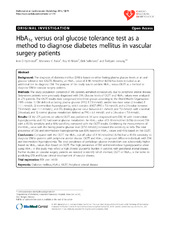| dc.contributor.author | Hjellestad, Iren Drange | en_US |
| dc.contributor.author | Astor, Marianne | en_US |
| dc.contributor.author | Nilsen, Roy Miodini | en_US |
| dc.contributor.author | Søfteland, Eirik | en_US |
| dc.contributor.author | Jonung, Torbjørn | en_US |
| dc.date.accessioned | 2014-05-02T09:26:08Z | |
| dc.date.available | 2014-05-02T09:26:08Z | |
| dc.date.issued | 2013-05-25 | eng |
| dc.identifier.issn | 1475-2840 | |
| dc.identifier.uri | https://hdl.handle.net/1956/7916 | |
| dc.description.abstract | Background: The diagnosis of diabetes mellitus (DM) is based on either fasting plasma glucose levels or an oral glucose tolerance test (OGTT). Recently, an HbA1c value of ≥48 mmol/mol (6.5%) has been included as an additional test to diagnose DM. The purpose of this study was to validate HbA1c versus OGTT as a method to diagnose DM in vascular surgery patients. Methods: The study population consisted of 345 patients admitted consecutively due to peripheral arterial disease. Sixty-seven patients were previously diagnosed with DM. Glucose levels of OGTT and HbA1c values were analyzed in 275 patients. The OGTT results were categorized into three groups according to the World Health Organization 1999 criteria: 1) DM defined as fasting plasma glucose (FPG) ≥ 7.0 mmol/L and/or two-hour value (2-h-value) ≥ 11.1 mmol/L; 2) intermediate hyperglycaemia, which consists of IGT (FPG < 7.0 mmol/L and a 2-h-value between 7.8 mmol/L and 11.1 mmol/L), and IFG (fasting glucose value between 6.1 mmol/L and 7.0 mmol/L with a normal 2-h-value); and 3) normal glucose metabolism defined as FPG < 6.1 mmol/L and a 2-h-value < 7.8 mmol/L. Results: Of the 275 patients on whom OGTT was performed, 33 were diagnosed with DM, 90 with intermediate hyperglycaemia and 152 had normal glucose metabolism. An HbA1c value of ≥ 48 mmol/mol (6.5%) detected DM with a 45.5% sensitivity and a 90% specificity compared with the OGTT results. Combining the measurements of the HbA1c value with the fasting plasma glucose level (≥ 7.0 mmol/L) increased the sensitivity to 64%. The total prevalence of DM and intermediate hyperglycaemia was 85% based on HbA1c values and 45% based on the OGTT. Conclusions: Compared with the OGTT the HbA1c cut-off value of ≥ 48 mmol/mol (6.5%) had a 45.5% sensitivity to diagnose DM in patients with peripheral arterial disease. OGTT and HbA1c categorized different individuals with DM and intermediate hyperglycaemia. The total prevalence of pathologic glucose metabolism was substantially higher based on HbA1c values than based on OGTT. The high prevalence of DM and intermediate hyperglycaemia when using HbA1c in this study may reflect a high chronic glycaemic burden in patients with peripheral arterial disease. Further studies on vascular surgery patients are needed to identify which method, OGTT or HbA1c, is the better in predicting DM and future clinical development of vascular disease. | en_US |
| dc.language.iso | eng | eng |
| dc.publisher | BioMed Central | eng |
| dc.relation.ispartof | <a href="http://hdl.handle.net/1956/20406" target="blank"> Biomarkers for Diabetes Mellitus in advanced Peripheral Arterial Disease. Diagnostic performance and outcome prediction of HbA1c, fasting plasma glucose and the oral glucose tolerance test</a> | |
| dc.rights | Attribution CC BY | eng |
| dc.rights.uri | http://creativecommons.org/licenses/by/2.0 | eng |
| dc.subject | Diabetes mellitus | eng |
| dc.subject | HbA1c | eng |
| dc.subject | OGTT | eng |
| dc.subject | Peripheral arterial disease | eng |
| dc.title | HbA1c versus oral glucose tolerance test as a method to diagnose diabetes mellitus in vascular surgery patients | en_US |
| dc.type | Peer reviewed | |
| dc.type | Journal article | |
| dc.date.updated | 2013-08-23T08:49:48Z | |
| dc.description.version | publishedVersion | en_US |
| dc.rights.holder | Copyright 2013 Hjellestad et al.; licensee BioMed Central Ltd. | |
| dc.source.articlenumber | 79 | |
| dc.identifier.doi | https://doi.org/10.1186/1475-2840-12-79 | |
| dc.identifier.cristin | 1045925 | |
| dc.source.journal | Cardiovascular Diabetology | |
| dc.source.40 | 12 | |

